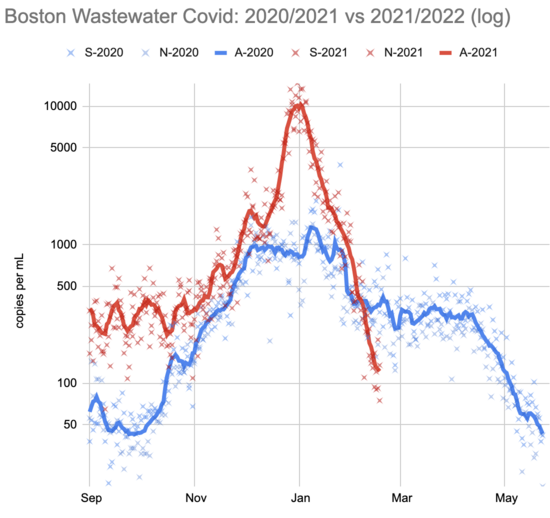Microcovid Becoming Less Useful |
February 19th, 2022 |
| covid-19 |
On the other hand, at this point, I think it has become substantially less useful, and in many cases is leading people to seriously overestimate the level of precautions that are appropriate for their particular situation:
Its data on prevalence is stale, because the automatic updater last ran successfully on 2022-02-07.
To determine how risky things are in your area it uses the average number of cases from last week. When cases are rising, it extrapolates to predict growth. On the other hand, when cases are falling (as they are now here, and have been for a while) it does not extrapolate and assumes that cases have stayed flat.
It's models the people you interact with as being equally likely to currently be infectious, regardless of their vaccination status. Vaccinated people, however, are less likely to get covid and are infectious for a shorter time period. [EDIT: possibly it is modeling the "less likely to get covid" piece but not "less likely to transmit if infected" and "infectious for less time" pieces?]
-
It defaults to a risk budget of 200 microcovids per week, a 1% annual chance of getting covid, regardless of what you tell it for your vaccination status. The highest budget it offers is only 10x that, for people who "can't avoid risk, but still want to make smart choices". This was a reasonable way of looking at things earlier in the pandemic, but at this stage I think much higher budgets are generally appropriate for fully vaccinated people: the risk to the individual is generally extremely low and the risk they impose on others is relatively low. Altruistically, since most of society is operating on a much higher risk budget keeping to low one is a lot of sacrifice for minimal benefit.
For a vaccinated and boosted person I think a better approach is to use no budget most of the time, and then use a budget of perhaps 10,000 microcovids/week (~50% annual risk) when demand on the medical system is likely to be especially high.
Even just the first two have a very large impact. For example, it currently gives a random person in my county as having a 0.78% chance of having covid (780 cases per 100k). Let's walk through the basic method with current data.
For the most recent seven days we've averaged 379 cases/day. Population is 1.6M, so that's 24/100k. The positive test rate is 2.2%. They have some math I don't entirely follow the reasoning for, with:
prevalence_ratio = 1250 / (day_i + 25) * positive_test_rate ** 0.5 + 2 true_infections = prevalence_ratio * reported_infectionsWhere
day_i is number of days since 2020-02-12 (738 as of
today). They cite Estimating
True Infections Revisited: A Simple Nowcasting Model to Estimate
Prevalent Cases in the US, but I'm just going to use it as is:
prevalence_ratio = 1250 / (738 + 25) * 2.2% ** 0.5 + 2 prevalence_ratio = 1.6 * 0.15 + 2 prevalence_ratio = 0.24 + 2 prevalence_ratio = 2.24 true_infections = 2.24 * 24/100k true_infections = 54/100k
Using current data moves the risk down 14x, from 780/100k to 54/100k.
Now let's apply the extrapolation that they do when cases are
rising. The seven days before that averaged 460 cases/day, or
29/100k. Test positivity was 4%, so prevalence_ratio is 2.33, and
estimated true_infections is 68/100k. Dividing 54 by 68
we get 79%, so the extrapolated current number is 79% * 54/100k.
Consistent downward extrapolation brings it down another 20%, from 54/100k to 43/100k, for a total of 18x. This extrapolation is warranted here, if you look at the (more current) wastewater numbers.
Comment via: facebook, lesswrong, substack
